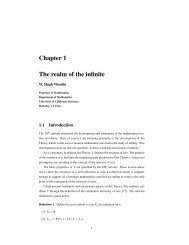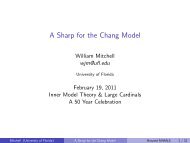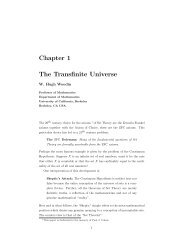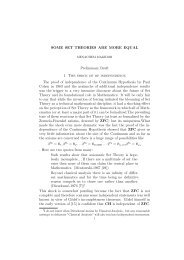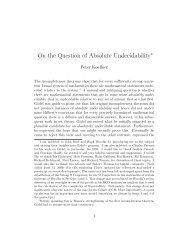The Continuum Hypothesis - Logic at Harvard
The Continuum Hypothesis - Logic at Harvard
The Continuum Hypothesis - Logic at Harvard
Create successful ePaper yourself
Turn your PDF publications into a flip-book with our unique Google optimized e-Paper software.
together showed th<strong>at</strong> CH cannot be resolved on the basis of the axioms th<strong>at</strong>m<strong>at</strong>hem<strong>at</strong>icians were employing; in modern terms, CH is independent ofZFC.This independence result was quickly followed by many others. <strong>The</strong> independencetechniques were so powerful th<strong>at</strong> set theorists soon found themselvespreoccupied with the meta-theoretic enterprise of proving th<strong>at</strong> certainfundamental st<strong>at</strong>ements could not be proved or refuted within ZFC. <strong>The</strong>question then arose as to whether there were ways to settle the independentst<strong>at</strong>ements. <strong>The</strong> community of m<strong>at</strong>hem<strong>at</strong>icians and philosophers of m<strong>at</strong>hem<strong>at</strong>icswas largely divided on this question. <strong>The</strong> pluralists (like Cohen)maintained th<strong>at</strong> the independence results effectively settled the question byshowing th<strong>at</strong> it had no answer. On this view, one could adopt a system inwhich, say CH was an axiom and one could adopt a system in which ¬CHwas an axiom and th<strong>at</strong> was the end of the m<strong>at</strong>ter—there was no questionas to which of two incomp<strong>at</strong>ible extensions was the “correct” one. <strong>The</strong> nonpluralists(like Gödel) held th<strong>at</strong> the independence results merely indic<strong>at</strong>edthe paucity of our means for circumscribing m<strong>at</strong>hem<strong>at</strong>ical truth. On thisview, wh<strong>at</strong> was needed were new axioms, axioms th<strong>at</strong> are both justified andsufficient for the task. Gödel actually went further in proposing candid<strong>at</strong>esfor new axioms—large cardinal axioms—and he conjectured th<strong>at</strong> they wouldsettle CH.Gödel’s program for large cardinal axioms proved to be remarkably successful.Over the course of the next 30 years it was shown th<strong>at</strong> large cardinalaxioms settle many of the questions th<strong>at</strong> were shown to be independent duringthe era of independence. However, CH was left untouched. <strong>The</strong> situ<strong>at</strong>ionturned out to be r<strong>at</strong>her ironic since in the end it was shown (in a senseth<strong>at</strong> can be made precise) th<strong>at</strong> although the standard large cardinal axiomseffectively settle all question of complexity strictly below th<strong>at</strong> of CH, theycannot (by results of Levy and Solovay and others) settle CH itself. Thus,in choosing CH as a test case for his program, Gödel put his finger preciselyon the point where it fails. It is for this reason th<strong>at</strong> CH continues to play acentral role in the search for new axioms.In this entry we shall give an overview of the major approaches to settlingCH and we shall discuss some of the major found<strong>at</strong>ional frameworks whichmaintain th<strong>at</strong> CH does not have an answer. <strong>The</strong> subject is a large one andwe have had to sacrifice full comprehensiveness in two dimensions. First, wehave not been able to discuss the major philosophical issues th<strong>at</strong> are lying inthe background. For this the reader is directed to the entry “Large Cardinals2





